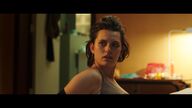The overall feeling is that the director is very fierce and the filming is very firm. Watching the movie is uncomfortable, but it has both beauty and rhythm. On the whole, the second half of the film is better. Some of the previous scenes are not well written, and the purpose and function are not clearly understood. When eating my sister's finger, it seems a bit sudden.
The overall style is the same. "Eat" runs from the beginning to the end, and becomes the main thread of the film's narrative and symbols. In addition, the director pays attention to and handles the body very carefully. The female protagonist's body is gradually developing from clothing to physical changes. The most important thing The thing is, the body and space are highly echoed, which can be seen from the first in-car scene.
In the car scene, the director intentionally highlights the tension between space and characters, and the inner uneasiness through detailed shots and jumps of viewpoints. The overall angle of the parents' backs and the girl's riding axis are constantly reinforcing this point. At this time, the director is telling the audience, (through the processing of space and character relationships), this may be an overhead, conceptual story. This is more clearly reflected in the next scene, that is, outside the car, the scene where parents and daughter say goodbye. This scene has only three cameras and a large panoramic view, which is intended to introduce the environment, followed by the foreign reaction of the daughter and mother. One is the total angle of the daughter and the mother, the father is in the depth of field, and the 2 and 3 switches back and forth, blurring the relationship between the space and characters, which is in line with the unrealistic style of the film.
The play in the school has obvious conceptual features since the quilt is thrown. The upward shot composition and light of the corridor are very peculiar, which is also a kind of "alienation" to the space. Getting off the elevator and going downstairs both have obvious meanings of "falling", but at the same time, with the change of space, the heroine also potentially accepts the new rules of the new space when switching between different spaces.
The space and light treatment in the basement make the reality of the space more blurred, but I feel that it can be more. The appearance of the pillars breaks this overhead design. This scene is a very obvious symbolic treatment. People from the dark place Crawling over is undoubtedly a hint of "degeneration". At this point, the director has told the audience what he wants to shoot, which is the most fundamental thing of human nature (so there must be various "falling" movements before). The handling of the scene scheduling in this scene is worth learning. When the character appears alone, he crawled over to the crowd behind him, and he couldn't see what he was doing. The man climbed for a while, but the audience didn't understand what it was. Meaning, why is he crawling, who is he, and what are the people behind him doing, but then the crowd behind him moves forward, and the audience can see that they are also crawling, and they show their breasts a lot. At this time, all the previous questions have been answered. It's a sense of rhythm and suspense achieved through single-shot mise-en-scene.
After climbing over, it is a party, no doubt, this is a perfect interpretation of the carnival theory.
What impressed me most was the scene where the heroine was in the bed. This scene was amazing. "The Three Gorges" uses dim lights, sweat, drinking water, blowing fans, and tight clothes to deal with sexual desire, but "Raw" is more conceptual, the heroine is trapped in the bed, the lights are bright, She is curled up, the whole picture is reminiscent of a baby in the womb. The heroine is restless because of her unbearable sexual desire. At this time, iron chains appear outside and beat her. At this time, the torment brought by sexual desire is two-sided. It comes from the heroine as a human being. The self, but also from the temptation of the outside world, she is like a baby finally reborn under the catalysis of sexual desire. So in the later plot, she walked into the man's room and was splashed with blue paint. She made out with a man who was splashed with yellow paint. The yellow and blue became the green of life, which was very symbolic and very visual. creative.
It is also worth mentioning that the heroine's self-identification is handled well. From spitting out her hair, to wearing her sister's clothes, to kissing the mirror lightly, to getting together with her sister, her process comes from both herself and her sister. The film is also constantly changing her voice, promoting her self-identity and ultimately liberating her sexually. The rhythm of this process is also very well handled, through the "dirty" sex to the "clean" bath, through the visual behavior or, the conceptual (but narrative logic) plot, the tortuous process is expressed. .
Let's do this first.
View more about Raw reviews











